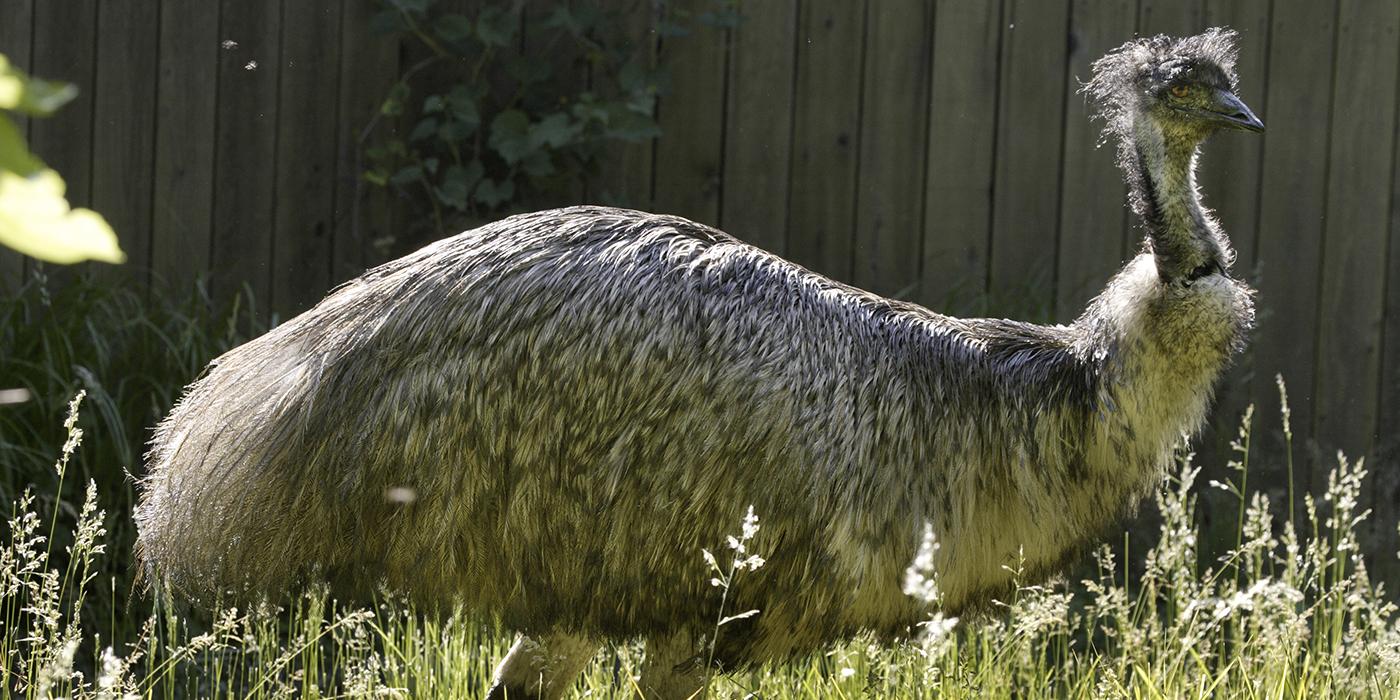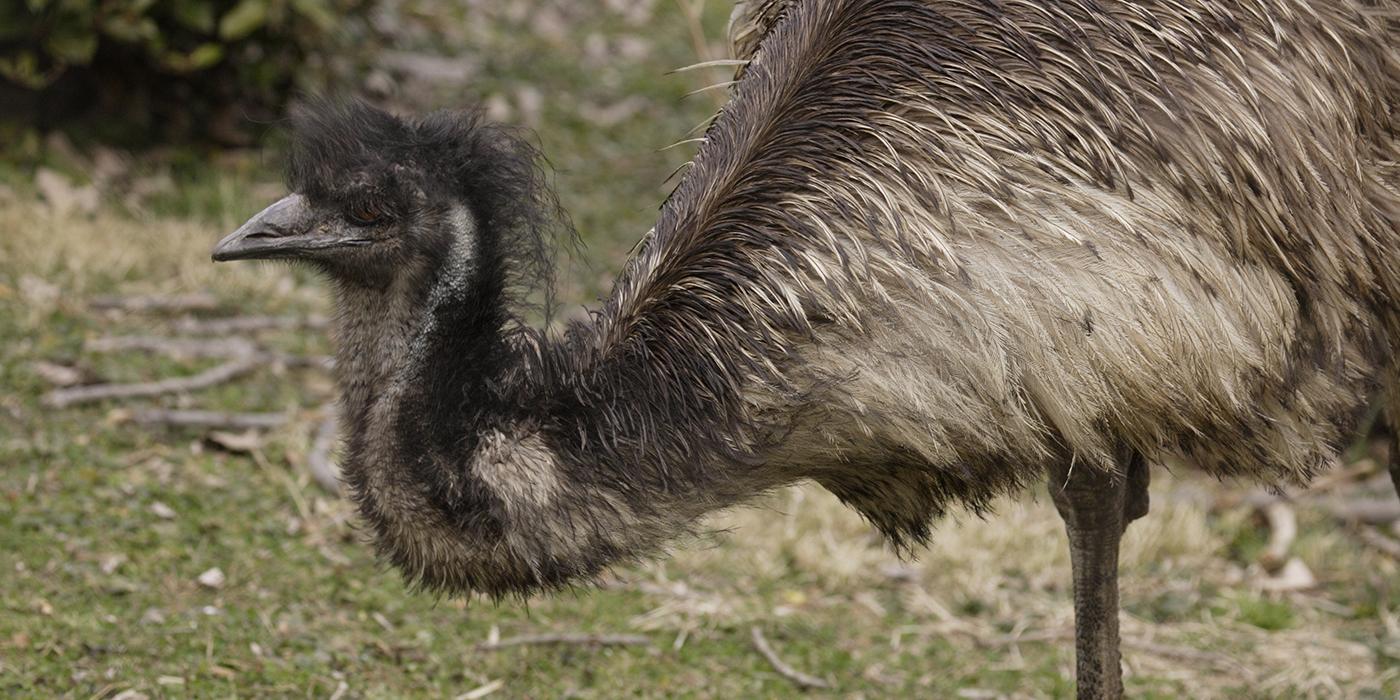Physical Description
Emus are large, flightless birds. Their necks and legs are long, but their wings are tiny, reduced to less than 8 inches (20 centimeters). After molting, the birds are dark, but sunlight fades the feathers and they become paler at the end of the season. Chicks have longitudinal stripes with black, brown and cream, so they blend easily into long grass and dense shrubbery. Emus have three toes.
Size
The emu is the second largest living bird and the largest bird found in Australia. Its height averages 5.7 feet (1.75 meters). Males weigh 110 to 121 pounds (50 to 55 kilograms), and females weigh about 11 pounds (5 kilograms) more than males.
Native Habitat
Emus live only in Australia, where they are widespread. Subspecies once existed on Tasmania and King Island, but they are now extinct. Emus live in eucalyptus forest, woodland, heath land, desert shrub lands and sand plains. It is found in desert areas only after heavy rains have caused growth of herbs and grasses and heavy fruiting of shrubs. Emus also live close to Australia's big cities, but are no longer found where native vegetation has been cleared for agricultural land.
Emu migrations may be a result of human agriculture. The establishment of artificial but permanent watering points in the Australian inland, where cattle and sheep graze, has enabled emus to expand into places from which they were previously excluded by lack of water. In some areas, they are now considered pests.
Lifespan
The emu lives five to ten years and longer in human care.
Communication
Males sometimes make calls, which sound like "e-moo" and can be heard over long distances. Females make resonant, booming sounds.
Food/Eating Habits
In arid Australia, emus will travel hundreds of miles to find another source of food or water. They must have daily access to fresh water. When food is abundant, an emu stores large amounts of fat, and is able to use this while looking for more food. Birds may lose up to 50 percent of their weight while searching for food. Emus pattern their movements to track with recent rainfall. They appear to depend mainly on the sight of rain-bearing clouds but sound cues from thunder and the smell of wet ground may also be involved.
Emus eat the parts of plants that have the most concentrated nutrients: seeds, fruits, flowers and young shoots. They also eat insects and small vertebrates when they are easily available. They will not eat dry grasses or mature leaves. Emus ingest large pebbles up to 1.6 ounces (45 grams) to help their gizzards grind up food. They also often eat charcoal.
At the Smithsonian's National Zoo, the emu is fed ratite pellets and occasionally greens such as kale and romaine.
Reproduction and Development
Before mating, the female makes dull, rattling, drum-like sounds, and the male builds a nest in his territory where the female later joins him.
The nest, made of leaves, grass and bark is a shallow depression next to low brush. It holds 15 to 25 eggs, which come from several hens. The males incubate the eggs. During incubation, which lasts 56 days, the male doesn't eat, drink or defecate. Once the male starts sitting, most females leave the territory, sometimes pairing with other males and laying further clutches. A few stay to defend the male on the nest, using their loud, booming call. Males are aggressive when the chicks hatch, driving the remaining females away and attacking anything else that approaches the nest. Newly hatched chicks weigh 15.5 to 17.6 ounces (440 to 500 grams). The male stays with the chicks for about five to seven months. Lost chicks from other broods are allowed to join another male's group, if they are smaller than his own offspring. The male may then mate for the next season's nesting. At two to three years of age, the young are fully mature and capable of reproduction.
Conservation Efforts
Emu farming began in Australia 70 years ago, and a wide range of products is manufactured from the emu. It is bred for its meat, as well as the skin for leather products. Emu oil is popular for its medicinal value.
Because young emus consume large quantities of caterpillars and grasshoppers, and adults eat burrs that entangle sheep wool, some farmers and ranchers find emus helpful. However, emus may stamp down wheat fields, eat large quantities of grain and jump over barbed wire fences.
Because of farmer complaints, the Australian government launched the "Emu War" in 1932. This was an attempt to eradicate emus using machine guns and grenades. The effort was largely unsuccessful, however, because emus are elusive, difficult to catch and adept at camouflage; it is reported that only 12 emus were killed. Instead, a 1,609-mile-long (1,000-kilometer-long) fence has been built that separates the emus from these cereal-growing areas of the southwest.
Help this Species
Share the story of this animal with others. Simply raising awareness about this species can contribute to its overall protection.
Smithsonian's National Zoo and Conservation Biology Institute. (n.d.). Emu. Retrieved December 25, 2025, from https://nationalzoo.si.edu/animals/emu




